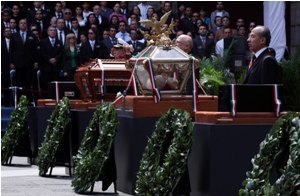Remains to be seen
Via Latin American Herald Tribune:
 The remains of 14 of the most important heroes of Mexico’s struggle for independence from Spain were transferred on Sunday from Chapultepec Castle in Mexico City, where they had been subjected to anthropological studies and preservation procedures, to the National Palace, also in the capital, where they will be on public display for 11 months.
The remains of 14 of the most important heroes of Mexico’s struggle for independence from Spain were transferred on Sunday from Chapultepec Castle in Mexico City, where they had been subjected to anthropological studies and preservation procedures, to the National Palace, also in the capital, where they will be on public display for 11 months.
The transfer was made on Sunday morning when a contingent of carriages and mounted squadrons of soldiers dressed in ceremonial uniforms took charge of the remains, which had been placed in gilded glass or wooden urns.
 The procession followed the emblematic Paseo de la Reforma avenue to the National Palace, located on one side of the huge central square known as the Zocalo, where thousands of people threw flowers and shouted “Viva Mexico!”
The procession followed the emblematic Paseo de la Reforma avenue to the National Palace, located on one side of the huge central square known as the Zocalo, where thousands of people threw flowers and shouted “Viva Mexico!”
The remains included those of Miguel Hidalgo y Costilla, Ignacio Allende, Juan Aldama, Mariano Jimenez, Jose Maria Morelos y Pavon, Vicente Guerrero, Leona Vicario, Mariano Matamoros, Guadalupe Victoria, Andres Quintana Roo, Nicolas Bravo, Javier Mina, Victor Rosales and Pedro Moreno…
Christopher Hitchens recently wrote about another “bicentennial exhumation”, that of Simon Bolivar. Given the British tendency to describe anything done in Latin America (or anywhere Roman Catholicism was a vital culture after 1600) in terms meant to suggest something perverse, and — since the only purpose in writing about the exhumation was to launch an ad hominum diatribe against Venezuelan President Hugo Chavez (to the point of stupidity, the author mistaking a quote from Pablo Neruda’s “Canto a Bolivar” for a prayer to Simon Bolivar) — his use of “political necrophilia” might be dismissed along with the rest of the hit piece. Still, there is some validity in the term.
The veneration of relics after all, is what prompted Luther to post his 95 thesis on the wall of the Wittenburg Castle church in 1517, and it has been the source of anti-Catholic snark every since. I suppose to a polemicist like Hitchens, describing veneration in a term normally used for sexual desire (and a perverse one at that) is natural. But, had Hitchens been writing about the Mexican heroes, I doubt he’d have used the same phrasing.
 I agree, the idea of looking at bones has limited appeal, but people have been doing that here (and in Mexico, saving the bones of honored enemies as well) for a very long time before Hugo Chavez was thought of. As I’ve pointed out before, the physicality of death does not shame us, nor is it denied. In Latin America, the reality of decay and dissolution is accepted, and the fact that any relics exist is something to be cherished. I don’t read anything into Chavez (who, after all, was the son of Catholic religious teachers and uses explicitly “Catholic” imagery and language in his speeches) overseeing Simon Bolivar’s exhumation — nor of Venezuelan television broadcasting images of Bolivar’s skeleton, any more than I do that of out-of-the-closet Catholic Felipe Calderón undertaking this mass exhumation and exhibition of less intact remains.
I agree, the idea of looking at bones has limited appeal, but people have been doing that here (and in Mexico, saving the bones of honored enemies as well) for a very long time before Hugo Chavez was thought of. As I’ve pointed out before, the physicality of death does not shame us, nor is it denied. In Latin America, the reality of decay and dissolution is accepted, and the fact that any relics exist is something to be cherished. I don’t read anything into Chavez (who, after all, was the son of Catholic religious teachers and uses explicitly “Catholic” imagery and language in his speeches) overseeing Simon Bolivar’s exhumation — nor of Venezuelan television broadcasting images of Bolivar’s skeleton, any more than I do that of out-of-the-closet Catholic Felipe Calderón undertaking this mass exhumation and exhibition of less intact remains.






Looking at bones has limited appeal? Maybe. But photographing them has all sorts of appeal! I’m British you see…we get morbidly fascinated by such things. Just look at all the bones and corpses we brought back from Egypt….
Hopefully it’ll be open on Wednesday morning. And photography will be permitted.